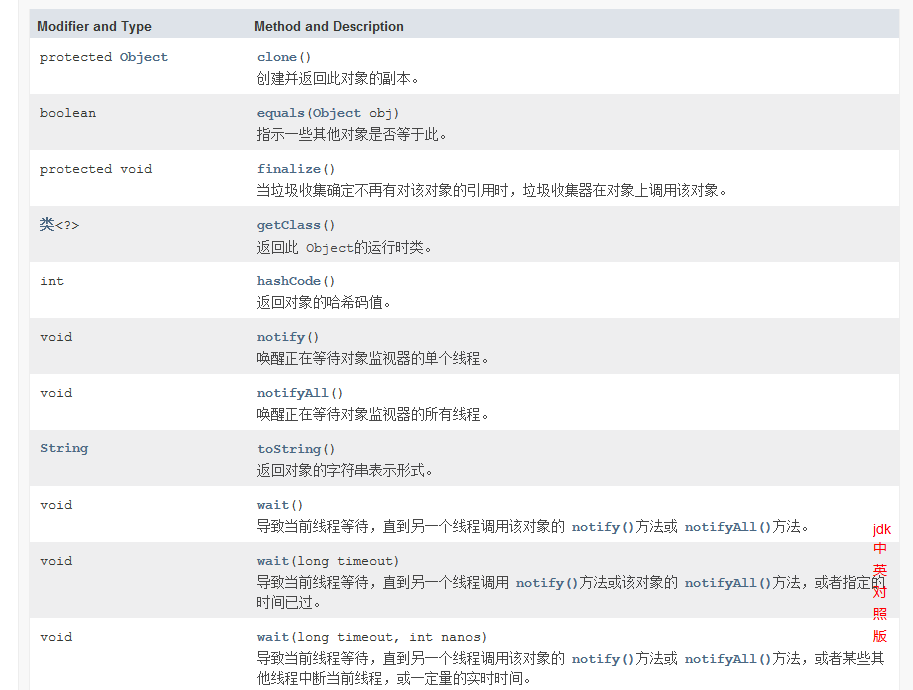J6-1 Object类
1.Object类
1.1概念
- 在java中Object类是所有java类的根基类,是所有类的老祖宗
- 如果在类的声明中未使用extends关键字指明其基类,则默认基类为Object类,例如
public class Persion{
}
//等价于
public class Persion extends Object{
}
1.2Object类中的方法
- Object类中提供的方法有如下几个

toString()方法,默认返回类名加一个哈希值,其内部实现方法如下.建议所有子类重写该方法
getClass().getName() + '@' + Integer.toHexString(hashCode())
package com.hanqi.demo1;
class Dog{
}
public class test07 {
public static void main(String[] args) {
Dog d = new Dog();
System.out.println("d:=" + d.toString());
System.out.println("d:=" + d);
}
}
///
d:=com.hanqi.demo1.Dog@15db9742
d:=com.hanqi.demo1.Dog@15db9742
/*重写toString方法之后*/
package com.hanqi.demo1;
class Dog{
public String toString() {
return "This is dog man";
}
}
public class test07 {
public static void main(String[] args) {
Dog d = new Dog();
System.out.println("d:=" + d.toString());
System.out.println("d:=" + d);
}
}
///
d:=This is dog man
d:=This is dog man
equals()方法,我们基于同一个类创建了2个对象,使用==后发现二者不一样,因为下述c1与c2存放的是指向堆内存的地址,明显不一样.那么如何来判断指向堆内存的东西是一样的呢?使用equals方法比较堆内存的东西是否一样,然神奇地发现equals与==效果差不多.自此我们对Object类中的equals方法十分不满,因此我们要重写之.注意java的包里面有些类已经实现了equals方法,如String类里面就实现了equals方法
package com.hanqi.demo1;
class Cat{
int color;
int height, weight;
}
public class test07 {
public static void main(String[] args) {
Cat c1 = new Cat();
Cat c2 = new Cat();
System.out.println(c1 == c2);
}
}
///
false
/*-------------------------------------------------------------------------------------------------*/
package com.hanqi.demo1;
class Cat{
int color;
int height, weight;
}
public class test07 {
public static void main(String[] args) {
Cat c1 = new Cat();
Cat c2 = new Cat();
System.out.println(c1.equals(c2));
}
}
///
false
/*-------------------------------------重写后-------------------------------------------------------*/
package com.hanqi.demo1;
class Cat{
int color;
int height, weight;
public Cat(int color, int height, int weight) {
this.color = color;
this.height = height;
this.weight = weight;
}
public boolean equals(Object obj) {
if(obj == null)
{
return false;
}
else
{
if(obj instanceof Cat)
{
Cat c = (Cat)obj;
if(c.color == this.color && c.height == this.height && c.weight == this.weight)
{
return true;
}
}
}
return false;
}
}
public class test07 {
public static void main(String[] args) {
Cat c1 = new Cat(1, 2, 3);
Cat c2 = new Cat(1, 2, 3);
System.out.println(c1.equals(c2));
}
}
///
true
2.对象转型
2.1概念
- 一个父类的引用类型变量可以"指向"其子类对象
- 一个父类的引用不可以访问其子类对象新增加的成员(属性和方法)
- 可以使用引用 变量 instanceof 类名来判断该引用型变量所"指向"的对象是否属于该类或者该类的子类
a instanceof Animal即a属于Animal类吗,a是动物吗?
- 子类的对象可以当作基类的对象来使用称为向上转型(upcasting),反之为向下转型(downcasting)
package com.hanqi.demo1;
class Animal{
public String name;
public Animal(String name) {
this.name = name;
}
}
class Cat extends Animal{
public String eyesColor;
public Cat(String n, String c) {
super(n); //调用父类构造方法
eyesColor = c;
}
}
class Dog extends Animal{
public String furColor;
public Dog(String n, String c) {
super(n); //调用父类构造方法
furColor = c;
}
}
public class test07 {
public static void main(String[] args) {
Animal a = new Animal("name");
Cat c = new Cat("catname", "blue");
Dog d = new Dog("dogname", "black");
System.out.println(a instanceof Animal); //true
System.out.println(c instanceof Animal); //true
System.out.println(d instanceof Animal); //true
System.out.println(a instanceof Cat); //false
/*此刻的a指向了Dog对象,但a原来是指向Animal对象的,而Dog对象内部又存在Animal对象(Dog继承自Animal),所以a只能访问到Dog内部属于Animal父类的成员*/
a = new Dog("bigyellow", "yellow");
System.out.println(a.name); //bigyellow
//System.out.println(a.furColor); //error!!!!
System.out.println(a instanceof Animal); //true
System.out.println(a instanceof Dog); //true
/*如果非得要a能访问Dog类的私有成员furColor,则需要将a强制转换为Dog类*/
Dog d1 = (Dog)a; //强制类型转换
System.out.println(d1.furColor); //yellow
}
}
3.动态绑定和多态
3.1概念
- 动态绑定是指"在执行期间(非编译期间)判断所引用对象的实际类型,根据其实际的类型调用其相应的方法
- 例如,下述实例中有2中动物均继承自Animal类
package com.hanqi.demo1;
class Animal{
public String name;
public Animal(String name) {
this.name = name;
}
public void enjoy() {
System.out.println("x叫声,xx...");
}
}
class Cat extends Animal{
private String eyesColor;
public Cat(String n, String c) {
super(n);
eyesColor = c;
}
public void enjoy() {
System.out.println("猫叫声,喵喵...");
}
}
class Dog extends Animal{
private String furColor;
public Dog(String n, String c) {
super(n);
furColor = c;
}
public void enjoy() {
System.out.println("狗叫声,汪汪...");
}
}
/*
class Bird extends Animal{
private String featherColor;
public Bird(String n, String f) {
super(n);
featherColor = f;
}
public void enjoy() {
System.out.println("鸟叫声,啾啾...");
}
}*/
class Lady{
private String name;
private Animal pet;
public Lady(String name, Animal pet) {
this.name = name;
this.pet = pet;
}
public void myPetEnjoy() {
pet.enjoy();
}
}
public class test07 {
public static void main(String[] args) {
Cat c = new Cat("mimi", "blue");
Dog d = new Dog("tom", "black");
//Bird b = new Bird("jiujiu", "yellow");
Lady l1 = new Lady("l1", c);
Lady l2 = new Lady("l2", d);
//Lady l3 = new Lady("l3", b);
l1.myPetEnjoy();
l2.myPetEnjoy();
//l3.myPetEnjoy();
}
}
分析:我们new了一只猫和一个人,在人里面有一个成员为Animal对象,我们将其指向了new出来的cat,实际上cat继承自Animal.所以按理来讲人内部只能看见cat对象中属于Animal的那部分成员,即name,此时不能访问Cat的成员变量eyesColor.在代码中我们访问的是Animal中的enjoy方法,而方法存在于代码段,并且在上述代码中存在3种enjoy方法,最终执行结果是调用实际new对应的方法,即我们new的cat,就会调用cat中的enjoy方法.
好处:我们可以用少量代码实现极佳的可扩展性,例如当我们新建一个动物的时候直接new即可,然后给




 浙公网安备 33010602011771号
浙公网安备 33010602011771号